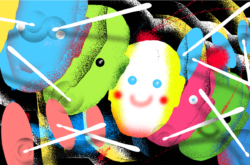Illustration: Michael Haddad
Much like ‘DAW,’ ‘MIDI’ is a term that’s most often referred to in its acronym form.
Both of these are examples of tools that nearly all music producers use, but many may not know exactly what they are or when and how to use them. In this article, we demystify what exactly MIDI is, and how you can get the most out of it as a music creator.
Let’s get started!
What is MIDI in music?
MIDI stands for Musical Instrument Digital Interface, and in its most simple form, is a language. Developed in the 1980s, MIDI represents the ability for your computer, external hardware, and any additional music software to most effectively communicate with one another.
While this seems like an obvious need, keep in mind that hardware synthesizers and computers as we know them were initially separate innovations. The original methods of synthesis didn’t take into account how instruments might communicate with a computerized DAW, nor did manufacturers make it a priority to process data in the same way as other synth creators.
So, by creating a universal method for compatibility, we became able to leverage music hardware to create and manipulate our sounds with more ease.
The history of MIDI
As the story goes, instrument-making leaders Roland, Oberheim, Sequential, and Moog were among the first to call for a universal language between their machines. The result, MIDI, would go on to define electronic music—and music production across all genres—as we know it. From the initial idea to a presentation at the famous NAMM conference just a few years later, music history was made almost instantly.
Perfect Circuit astutely compares this push for standardization to how VHS beat out Betamax as the industry standard for video. This was of course a precedent to DVD, which then ceded to Blu-ray. In the case of MIDI, the unification of key leaders in the space allowed for the development to be swift, collaborative, and forward-thinking—so much so that it took over 30 years for an update to the coding, MIDI 2.0, to be released and for industry adoption to begin.
A few years prior, The GRAMMYs honored MIDI’s founders with a technical award. The next such award recipient, perhaps for MPE (touched on below), remains to be seen.
What makes MIDI so important?
Unlike audio recording, in which a performance is captured and reconstructed digitally, MIDI data is solely information. This means that, while you may still capture a take on a MIDI keyboard or another controller, the resulting file is only a collection of data. Generally, this is visualized within what’s called a piano roll.
That said, keep in mind that without an instrument selected within your DAW, no playback will be available. The data needs something to speak through, of which there are endless purchasable and free options to choose from.
Here’s what selecting an instrument might look like in your DAW:
Loading an instrument in Bitwig Studio
In many ways, post-production is far more dynamic with MIDI as compared to audio. While you can keep a track exactly as you’ve performed it, you also have the full ability to correct your mistakes, change the timbre, and completely overhaul the pattern through methods like inversing, reversing, and quantizing. In this way, MIDI data is the ultimate musical scratchpad—performance is no longer the only way to create dynamic music.
Settings and parameters to know
Your DAW will likely offer a number of setting controls for your external controllers. These will determine a number of things, but most broadly, how much control of the MIDI output comes from the DAW’s settings or those of your controller. Parameters like track, sync, and remote can be set for each controller individually, and make a big difference in how MIDI data is captured.
A piece of advice for whenever you’re unsure: Activate the help text, which most DAWs will display on the bottom-left corner of their interface when you hover over a given parameter.
It’s also crucial to understand the difference between MIDI in, out, and thru. As you would use an electric instrument and its amplifier, the output of your instrument (such as your MIDI keyboard) should connect to the input of the source recording it. If you, however, have more than one controller in use, you can connect these separately, or chain them together through the use of MIDI thru ports. This will allow for a single stream of MIDI, made unique by how you decide to combine instruments and their settings.
Finally, consider your hardware when setting up your studio flow. With MIDI came a new cabling system, which has a distinct look due to its five-pin structure. These pins are thinner than the three you may know from an XLR cable, and create a peculiar shape to join the other outs on the back of your audio interface or rack gear.
The good news is that you may not need to purchase these cables, as much gear today will also allow for USB connectivity. While you may need to pick up a port for additional USB imports on your computer, you generally won’t need to pick up any extra adapters or accessories.
MPE: The future of MIDI
In addition to the updates that came with MIDI 2.0, the most significant innovation in this sphere is MIDI Polyphonic Expression, or MPE. A dense name, but an accurate one—instruments utilizing this are able to expand beyond monophonic playing; you hear the note you play, and only small dynamic differences are possible, like with a piano key. The format is meant to translate the highly expressive nature of acoustic instruments to MIDI, which, again, is completely digital.
We could fill an entire blog post with this, but for now, one of the key pioneers of MPE has put together a helpful history for you.
Free MIDI downloads
If you’d like to get started with a range of different MIDI patterns, below are three MIDI patterns generated by Beatmaker, a powerful plugin available in the Splice Creator plan.
Here are three drum patterns, generated at random by Beatmaker and tweaked to preference:
You can download all of the MIDI files for free here.
Now, remember when we said MIDI’s sound all depends on the virtual instrument selected? Let’s put that to the test, pushing that last drum pattern through a synth patch in Astra:
Sounds nice for a vintage Mario game when Bowser enters the room, but perhaps not so much for your music. While this is an example to show how MIDI may not always translate effectively between instruments, it can work the other way as well! A great trick to keep up your sleeve is to continuously write MIDI patterns that you like. Write chord progressions, arpeggios, or melodies—whatever speaks to you—and save them somewhere. When you’re feeling stuck in a piece, scrolling through old MIDI patterns and hearing them imagined in new keys, tempos, and instrumentations can go a long way in keeping your creativity flowing.
For more free MIDI files and compositional techniques, be sure to also check out these articles.
Explore royalty-free one-shots, loops, FX, MIDI, and presets from leading artists, producers, and sound designers:
December 14, 2023



